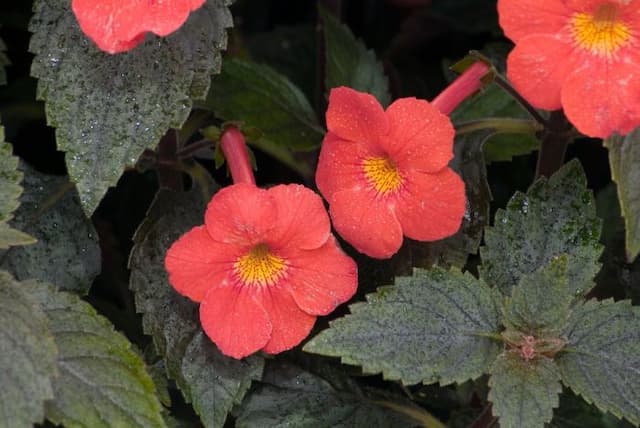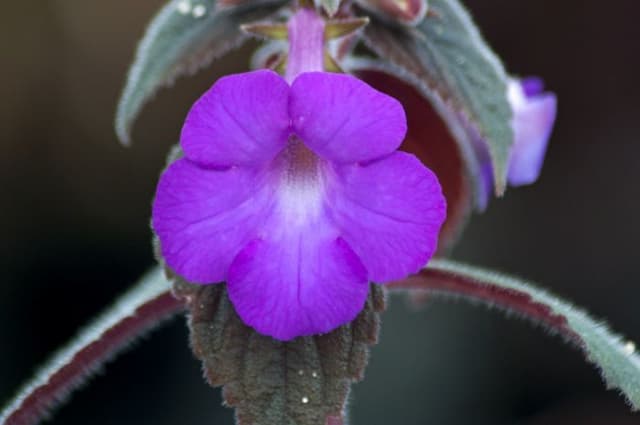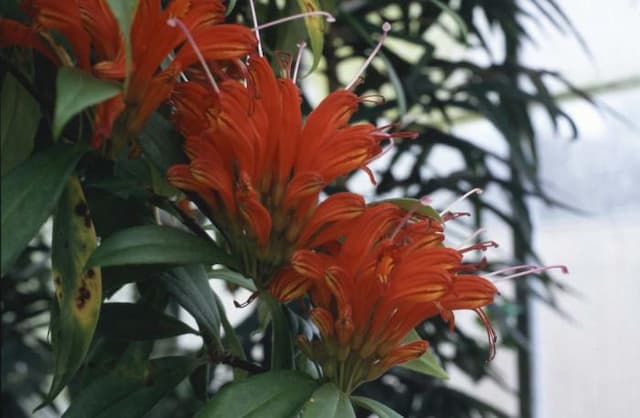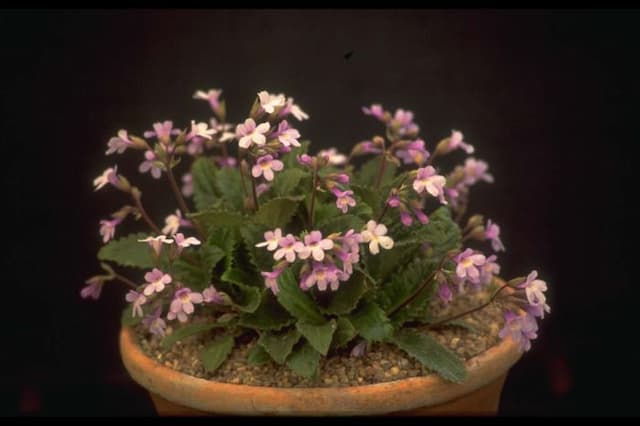Cape Primrose Streptocarpus 'Celebration'

ABOUT
The Streptocarpus 'Celebration', commonly known as Cape Primrose, showcases a lush and vibrant appearance. This particular variety is valued for its striking flowers, which present a dazzling display of color, ranging from purples and blues to bright pinks and occasionally whites. The blossoms typically feature throats that contrast in hue, adorned with intricate patterns or spots, contributing to their ornamental allure. Leaves of the Cape Primrose are elongated and softly textured, with a velvety surface that contributes to the tactile experience of the plant. Their deep green color provides a lush backdrop for the flowers, further accentuating their visual impact. The foliage emerges in a basal rosette pattern, creating an attractive, dense mound that supports the floral display above. Overall, the Cape Primrose 'Celebration' is cherished for its beautiful blooms and decorative foliage, making it a popular choice for indoor plant enthusiasts seeking to add a splash of color and elegance to their surroundings.
About this plant
 Names
NamesFamily
Gesneriaceae
Synonyms
Cape Primrose, African Violet, Twisted Seed Plant
Common names
Streptocarpus 'Celebration'
 Toxicity
ToxicityTo humans
Cape primrose, specifically the Streptocarpus 'Celebration' variety, is not known to be toxic to humans. There are no well-documented cases of poisoning or toxic reactions from ingesting or touching this plant. However, it is always a good practice to avoid ingesting plants that are not intended for consumption as they may cause irritation or an allergic reaction in some individuals.
To pets
Cape primrose, including the Streptocarpus 'Celebration', is generally considered non-toxic to pets such as dogs and cats. Ingestion of this plant should not cause any significant symptoms of poisoning. However, it can potentially cause mild gastrointestinal upset if ingested in large quantities, as with any non-food item eaten by animals.
 Characteristics
CharacteristicsLife cycle
Perennials
Foliage type
Evergreen
Color of leaves
Green
Flower color
Varies
Height
6 inches (15 cm)
Spread
12 inches (30 cm)
Plant type
Herb
Hardiness zones
10
Native area
South Africa
Benefits
 General Benefits
General Benefits- Easy Care: Streptocarpus, commonly known as Cape Primrose, requires minimal attention and can thrive with basic watering and light requirements.
- Long Blooming: Cape Primrose often blooms for long periods, sometimes even year-round, providing continuous color and interest.
- Shade Tolerant: This plant can grow well in shaded areas where other flowering plants may struggle to bloom.
- Variety of Colors: Streptocarpus 'Celebration' comes in various colors, allowing for a diverse and vibrant display.
- Compact Size: Cape Primrose is suitable for small spaces, including windowsills and tabletops, due to its compact growth habit.
- Ornamental Foliage: In addition to its flowers, Streptocarpus has attractive foliage that adds to its ornamental value.
- Ideal for Containers: It is an excellent choice for pot culture, making it a versatile plant for indoor and outdoor decorating.
 Medical Properties
Medical PropertiesThis plant is not used for medical purposes.
 Air-purifying Qualities
Air-purifying QualitiesThis plant is not specifically known for air purifying qualities.
 Other Uses
Other Uses- Decorative Art: The flowers of the Cape primrose can be used to make delicate pressed flower art for decorative purposes, such as greeting cards or bookmarks.
- Educational Tool: Horticulture educators can use Cape primrose to teach students about the care and propagation of houseplants, as well as hybridization.
- Photography Subject: The vibrant blooms and interesting foliage make Cape primrose a popular subject for photographers, especially those specializing in botanical imagery.
- Theme Gardens: Cape primrose can be included in theme gardens that focus on African flora, as it is native to South Africa and nearby regions.
- Color Dye: Petals of the Cape primrose may be used in crafting natural dyes for coloring fabrics, though this is not a common use.
- Botanical Illustration: Artists may utilize the plant in botanical illustrations, which serve as both scientific documentation and aesthetic expression.
- Floral Arrangements: Although more fragile than typical cut flowers, the Cape primrose can be used in small, live floral arrangements when handled carefully.
- Fragrance Enhancement: Some varieties of Cape primrose have lightly scented flowers that could contribute to the fragrance profile of a room or garden area.
- Wedding Decor: Its striking flowers could potentially be used as part of table decorations or bouquets in weddings, particularly in small, intimate settings.
- Seasonal Displays: During its flowering season, the Cape primrose can be incorporated into seasonal indoor displays, such as a spring-themed centerpiece.
Interesting Facts
 Feng Shui
Feng ShuiThe Cape Primrose is not used in Feng Shui practice.
 Zodiac Sign Compitability
Zodiac Sign CompitabilityThe Cape Primrose is not used in astrology practice.
 Plant Symbolism
Plant Symbolism- Resilience: Streptocarpus, commonly known as Cape primrose, often symbolizes resilience due to its ability to thrive with minimal care and in conditions that would be challenging for other plants.
- Enduring Love: As a flowering plant with long-lasting blooms, the Cape primrose can represent enduring love, suggesting a relationship that perseveres despite difficulties.
- Hope: With its bright flowers and continuous blooming habit, Cape primrose is often associated with hope and the idea of looking forward to positive outcomes.
 Water
WaterCape Primrose, which is the common name for Streptocarpus 'Celebration', prefers consistent moisture but does not like to be waterlogged. It's best to water when the top inch of soil feels dry to the touch, which typically means watering once a week. However, this can vary depending on environmental conditions like temperature and humidity. When watering, use room temperature water and apply it directly to the soil, avoiding the leaves. It's important to water thoroughly until it runs through the drainage holes, indicating that the entire root ball has been moistened, and then allow the excess to drain. Depending on the size of your pot, this might mean using about 8-16 ounces of water per watering session.
 Light
LightFor the Cape Primrose, bright, indirect light is optimal. This means placing the plant in an east- or north-facing window where it can receive some morning sun or diffused light throughout the day without the harshness of direct afternoon rays. A spot that maintains this lighting condition without exposing the plant to extended periods of direct sunlight is ideal as it allows the plant to grow without the risk of leaf burn.
 Temperature
TemperatureThe Cape Primrose thrives in a temperature range typically found in average home environments. The ideal temperatures for this plant are between 60 and 75 degrees Fahrenheit. While it can tolerate minimum temperatures down to 50 degrees Fahrenheit and maximum temperatures up to around 85 degrees Fahrenheit, staying within the ideal range encourages healthy growth and flowering.
 Pruning
PruningCape Primroses benefit from regular pruning to remove faded flowers and dead or yellowing leaves, which encourages new growth and helps maintain a tidy appearance. The best time to prune is immediately after a bloom cycle as this can also promote a more vigorous return to flowering. Pruning every few weeks or as necessary during active growth will keep your plant looking its best.
 Cleaning
CleaningAs needed
 Soil
SoilCape Primrose thrives in a well-draining soil mix, such as equal parts peat, perlite, and vermiculite. The pH should be slightly acidic to neutral, ideally between 6.0 and 7.0 for optimal growth.
 Repotting
RepottingCape Primrose should be repotted annually to renew the soil and to accommodate plant growth. Spring is the best time to repot this plant, just before the onset of its vigorous growing season.
 Humidity & Misting
Humidity & MistingCape Primrose prefers moderate to high humidity levels, around 50-60%. It thrives in environments where the air feels slightly moist but is not overly damp or humid.
 Suitable locations
Suitable locationsIndoor
Bright, indirect light and consistent moisture.
Outdoor
Sheltered spot, dappled sunlight, frost-free areas.
Hardiness zone
10-11 USDA
 Life cycle
Life cycleStreptocarpus 'Celebration', commonly known as Cape primrose, begins its life cycle as a seed, typically germinating in moist, warm conditions with indirect light. After germination, the seedling emerges and establishes a small rosette of leaves; during this vegetative stage, the plant focuses on leaf growth and root system development. As it matures, the Cape primrose enters a flowering stage, where it produces vibrant, trumpet-shaped flowers that arise from the base of the leaves, and this stage can last for many months with the right care. Following pollination, which is often facilitated by insects, the flowers will fade, and seed capsules develop, eventually drying and releasing seeds for reproduction. Under favorable conditions, the plant can enter a cycle of dormancy, where growth slows or ceases during shorter, cooler days, to resume when the growing conditions improve. The Cape primrose can live for several years, continuously growing and flowering, often with periods of pruning or leaf-cutting by gardeners to encourage more robust growth and flowering.
 Propogation
PropogationPropogation time
Spring-Early Summer
Streptocarpus 'Celebration', commonly known as Cape Primrose, is best propagated during its active growth period, which is typically in spring and summer. Leaf cuttings are the most popular method for propagating Cape Primrose. To do this, a healthy leaf is selected and a section at least 2 inches long (5 centimeters) is cut across the leaf's width. The cut edge is then placed into a moist, well-draining potting mix. Enclosing the pot in a plastic bag can create a humid environment which helps the cutting root more quickly. Roots usually develop within a few weeks, after which the new plant can be potted up separately. It's important to maintain moderate humidity and avoid direct sunlight during the initial rooting phase to encourage successful propagation.









